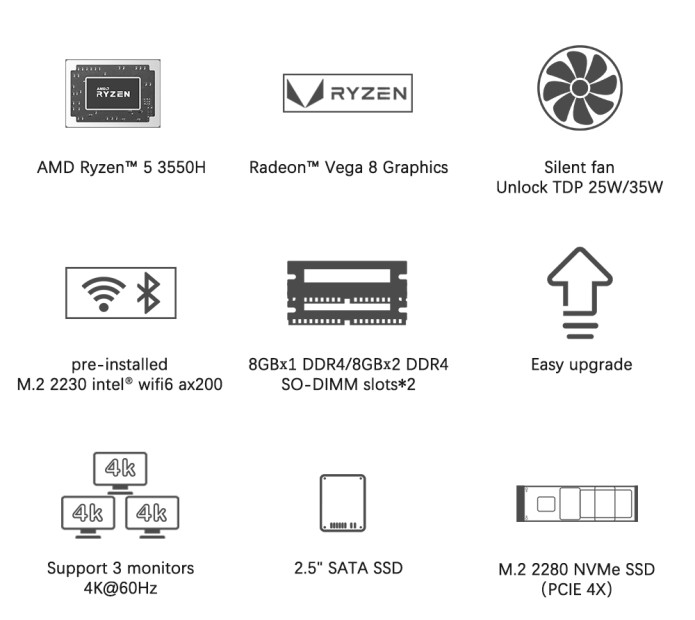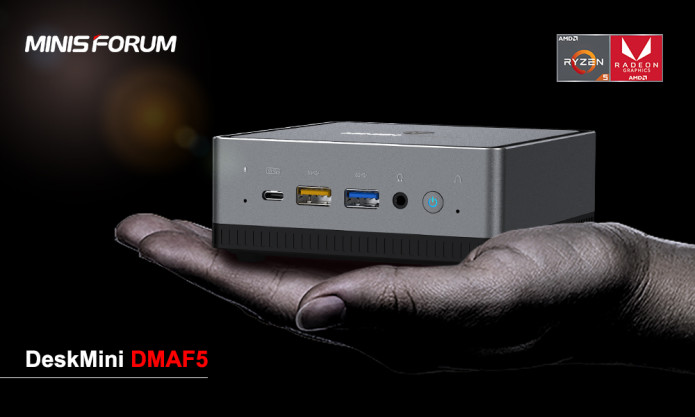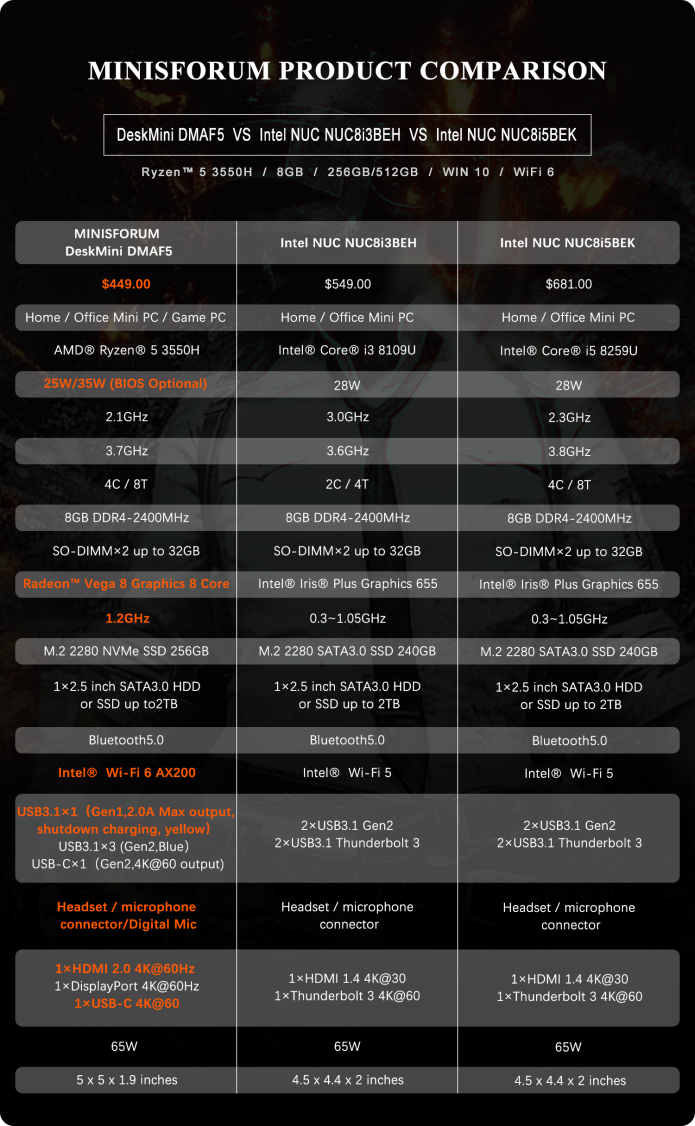Just a couple months ago, Minisforum started to talk abit about releasing an AMD based APU MiniPC that could potentially rethink and refresh the idea of a MINI PC.
A few years ago, such tiny PCs were a thing, and to some degree, it still is today. But what the architecture of CPUs were back then were running too hot and running too slow. As demonstrated and reviewed in my Gigabyte BRIX back then, the AMD A8-5557M was hot, slow, and noisy. Not exactly what you want in an APU and even a small block PC.
http://paulstechinsights.blogspot.com/2015/04/review-of-gigabyte-brix-a8-5557-r9.html
Fast forward 5 years on since April 2015. I still think Small PCs have their place and can excel given the right environment and architecture. Today I have backed what would have been a worthy successor to the Gigabyte BRIX which I still have after reviewing that. It's by a company called MinisForum and their campaign on Indiegogo just went live a day or two ago.
And for everyone's info, I initially thought of myself more into gaming PCs. But lately not so, I'm a sucker for mini PCs. I have an Alienware Alpha, the aforementioned BRIX that is now upstairs in my brother's flat above mine, a Mini Chuwi Minibook. All good SFF machines. But I'd like to be sure that this one is a good one after I get mine from the campaign.
Now I know that Ryzen has already come out on smaller form factor PCs like the AsRock Desk mini A300 STX. However, this is the first time a company is putting that into a Brick Form Factor that's barely the size of your hand, maybe even smaller. And given how successful and how well Ryzen has aged over the last 2-3 years, now's the time to give this Super SFF idea a try again.
FEATURES

Specs
AMD Ryzen 5 3550H (4C8T)
2 SODIMM DDR4 RAM slots (starts at 1x8GB 2400 DDR4 Module, supports up to 2x16GB)
M.2 2280 nVMe SSD (Starts at 256GB)
2.5" SATA Bay (1TB HDD at stretch goal)
AMD Vega 8 Graphics (512 Stream Processing Units)
WiFi 6 Standard (Intel AX200)
Cutting short to the chase here, The tiny PC, codenamed the Deskmini DMAF5, is meant to be still upgradable, and easily serviced too. In a video with Linus Tech Tips, it just opens up with 2 press tabs to reveal the innards just by pushing the top of the device. It already starts off with a base 8GB RAM, and an M2 SSD. However you can still expand it even further with a 2.5" drive that can be installed in its bay as well as a 2nd SODIMM Slot for further increasing its RAM. On Indiegogo you can also top up the extra to have the 1st SODIMM slot taken by a 16GB RAM module instead, so it can go up to 32GB which is more than plenty for an office PC or HTPC. However it is a slower RAM kit at 2400MHz and being AMD, higher RAM speeds will affect user experience on AMD more than Intel does. I'm hoping that MinisForum will up RAM speeds to 2666 or 2800 MHz because this will also help graphics performance for the VEGA 8
The cream of the crop is the Quad Core SMT Ryzen APU / SoC. The 3550H. I know that the 4000 series is already in the market and wished that they update the models as such but the 3550H is still by no means a slouch of a Quad Core. And the fact that it does come with Ryzen VEGA 8 integrated Graphics means that it has some muscle for graphically intensive tasks. The 512 Stream Processing units on it should perform about as well as the intel's Iris 655 counterparts.
With that all said, the DMAF5 is said to be as comparable if not better than Intel's NUC offerings for a significantly cheaper price as shown in the comparison table below even if the dimensions are ever so slightly bigger. But being AMD, Thunderbolt 3 is absent which is a shame.
However your WiFi does get the WiFi 6 standard which increases efficiency over crowded areas. That's one of the features the competition, the NUC don't have. And also, thanks to overwhelming support, the SSD which was originally configured for SATA is now being tested for an NVMe upgrade. I don't usually fuss about SSDs being super speedy, but rather to ensure a snappy OS at the very least. But it'll be nVMe by the time this rolls out.
PRICE:
At time of this writing, the Super Early Bird of 399 USD is already gone, leaving the 429USD version in the Early Bird Pack. It's not exactly cheap but you're paying for that space saving feature. Lucky I was among the first 20 to back the Super Early Bird Perk which is pretty much the sweet spot for the PC. Initially the first 1500 Contributor IDs will receive an additional micro keyboard free. Not exactly the most usable add on but for a HTPC and a mini keyboard makes sense. This has been changed however thanks to a stretch goal, to a 1TB 2.5" HDD which is great. And the nVMe speed bump being testing is welcome at this price point.
COMPETITORS:
As far as competition goes, as of 21st August 2020, another of such device has appeared on the market. Beelink has entered the competition with a similar device with the same CPU.
Bottomline is you have an AMD equivalent of a NUC but slightly bigger, no thunderbolt but quite a fair bit cheaper with WIFI 6, nVMe. It can also be expanded and upgraded to some extent with more RAM and an extra 2.5" drive which is now a stretch goal already achieved. However as of this update on the 16th August 2020, you can also top up 40 USD for another 8GB of DDR4 RAM which I did and is actually quite reasonable and you don't need to fuss with RAM upgrades anymore. I know people with 16 can also up to 32 but I'm not sure as to how much users will need to top up. It remains to be seen how well it will perform, which I will be testing for once it arrives in October. Also aforementioned with the hard drive, which means I don't need to tinker with the machine right out of the box!
I was regretting of not getting the Chuwi HiGame as it is more powerful in the gaming department. But the mini will to do.
TESTS ONCE IT HAS ARRIVED:
Gonna be a while till it does but my plan is to pit this against my Gigabyte P27G v2 Laptop that has been my bedside daily driver that recently has some plaguing issues especially when it comes to hibernating or turning off the hard drives. But also competing against some old scores that I have with the Gigabyte BRIX.
The laptop has the following Specs:
Core i7 4810MQ 4C8T
16GB DDR3 RAM
GTX 860M
Where the Gigabyte Brix has
AMD A8 5557M
6GB DDR3 RAM
Radeon R9 M275X / Radeon Mobility 8890M
Because my main idea of this miniPC is to see whether it can directly replace my Laptop and see how much better it is over the Gigabyte BRIX. Because CPU spec-wise they have the same number of cores but the BRIX's one doesn't have SMT and the architecture is way off compared to the Ryzen. The 5557M is based off of the Richland architecture, actually a derivative of Bulldozer which was quite bad. And now with Ryzen we'll see how it stacks up against my 4810MQ. Should be very similar!
But we'll see!









